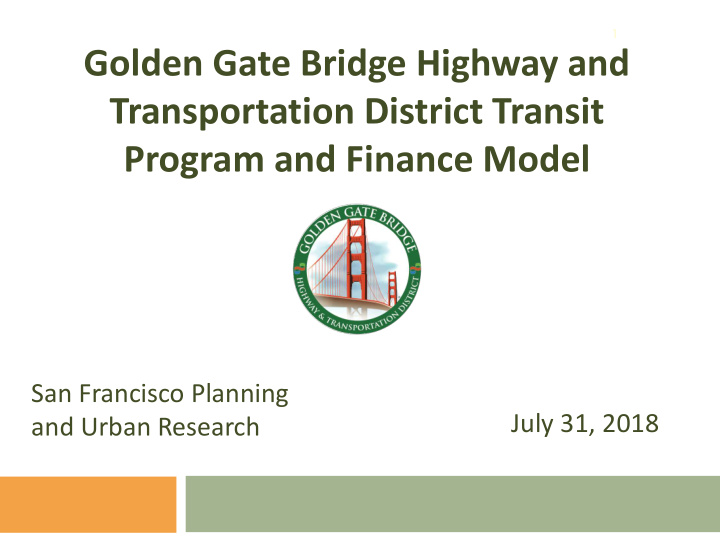



1 Golden Gate Bridge Highway and Transportation District Transit Program and Finance Model San Francisco Planning July 31, 2018 and Urban Research
Golden Gate Bridge Highway and Transportation District is a Multimodal Agency ¨ Bridge: The Golden Gate Bridge ¨ Highway: Alexander Avenue at the north end of the Bridge ¨ Transportation: Original mission modified in 1969 to include operating “Transportation Services” to reduce Bridge traffic using surplus toll funds ¤ Golden Gate Ferry (1970) ¤ Golden Gate Transit Regional Bus (1972) n Greyhound Lines wanted to discontinue local bus business 2
Moving from Private Sector Financing of Transit to Public Sector Greyhound was losing money and GGBHTD created a new system petitioned CPUC to end service ¨ Bridge Tolls and Federal Operating funds would pay for service ¨ Federal Capital Funds would pay 80% of the cost of new buses 3
Private Sector to Public Sector Greyhound provided buses New GGT buses provided reclining without many amenities seats and air conditioning 4
Regional Bus Service Types ¨ Commute Routes: 2, 4, 8, 18, 24, 27, 38, 44, 54, 56, 58, 72, 72X, 74, 76 & 101X ¤ Weekday peak periods, designed for work trips ¤ Express service – fewer stops, shorter travel times ¤ Higher farebox recovery rate ¨ Basic Routes: 30, 40, 70, & 101 ¤ Usually operate all day, 7 days per week for mobility needs ¤ Regular service – more stops, longer travel times ¤ Lower farebox recovery rate ¨ Marin Transit Local Contract Service ¤ Not covered in this presentation 5
Regional Ferry Service ¨ Sausalito (established 1971) 2,035 weekday riders ¤ ¨ Larkspur (established 1976) 6,260 weekday riders ¤ ¨ Tiburon (established 2017) 809 weekday riders ¤ 6
Regional Bus Service Characteristics ¨ Trip origins and destinations ¤ Commute routes – primarily to/from San Francisco ¤ Basic routes – variety of locations throughout service area ¨ Typical number of weekday passengers ¤ 16,600 ride total system ¤ 11,200 ride basic & commute routes n 6,800 on commute routes – 5,900 to/from SF n 4,400 on basic routes – 2,000 to/from SF n 7,900 total passengers to/from SF 7
Clipper Market Penetration Rates ¨ Bus: “Extended Use” Clipper cards ¨ Ferry: “Extended Use” or “Limited Use” cards ¨ High use of Clipper on GGT commute buses ¤ 89% of passengers use Clipper card overall ¨ Use on Regional Basic bus routes is mixed ¤ 43% of passengers use Clipper card overall ¤ 56-67% of Marin-San Francisco basic riders use Clipper ¤ 39% of Sonoma-Marin basic riders use Clipper ¤ Only 16-22% of Marin Local riders on Regional basic use Clipper ¨ High use of “Extended Use” cards on Larkspur Ferry but Sausalito Ferry lags due to tourists ¤ On average, 67% of ferry passengers use “EU” Clipper card 8 ¤ Usage rates: Larkspur 81%; Sausalito 43%; Tiburon 87%
GGBHTD Financing FY 18/19 District Operating Budget ¤ $230 million in expenses ¤ $226 million in revenues n Bridge tolls contribute $151.7 million n Transit fares contribute $37.4 million n Operating assistance covers $18.4 million n Other funds cover $18.7 million n Reserves will cover shortfall of $4.0 million 9
Where will the money come from in FY 18/19 to operate all of GGBHTD? 10
Where will the money go to operate GGBHTD in FY 18/19? 11
GGBHTD FY 18/19 Transit System Funding ¨ Transit Operating Expenses: $150 million ¤ GGT Bus $104.6 million (69.7%) ¤ GG Ferry $ 45.5 million (30.3%) ¨ Revenues: ¤ Toll Subsidy: $ 74.2 million (49.4%) ¤ Fares: $ 37.4 million (24.9%) ¤ Other Revenues: $ 15.9 million (10.6%) ¤ Govt. Grants: $ 18.7 million (12.4%) ¤ Reserve Funds: $ 3.9 million ( 2.6%) 12
Revenue Streams to Support Transit ¨ Annual Toll Increase (Five Year Plan) ¤ Last increase in plan effective July 1, 2018 ¤ New Five Year Plan under development for July 1, 2019 ¨ Five Year Transit Fare Increase Plan ¤ Each July 1, fares increase approximately 4% ¤ Current program extends until June 30, 2022 ¤ Goals of 25% farebox recovery for bus and 40% farebox recovery for ferry 13
Recommend
More recommend